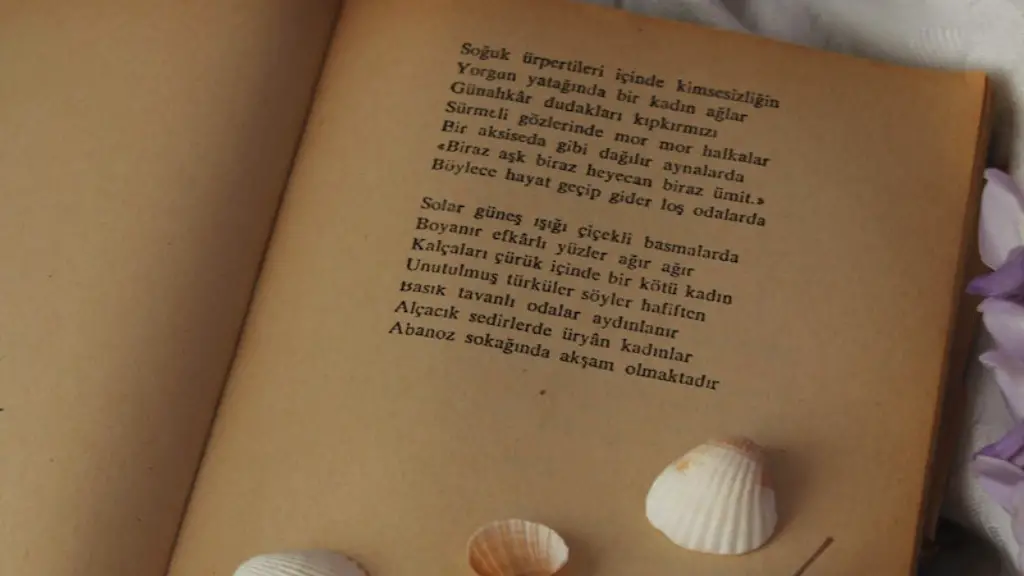Robert Frost is an American poet known for his modern style of writing. His works often explore themes of nature, pastoral beauty, and rural life. He often uses language that is simple yet evocative to convey complex feelings and emotions. Frost’s works are marked by the use of visual imagery, symbolism, and extended metaphor. He is particularly known for his frequent use of iambic pentameter and blank verse. He also uses a variety of techniques such as personification, repetition, and alliteration to add texture to his writing.
Frost’s writing style is often identified by its sparse, unadorned diction. His use of short, simple phrases with everyday words gives his poems a direct, straightforward appeal. Despite the apparent simplicity of his verse, Frost often creates vivid imagery and delicate nuance with the subtlest of turns of phrase. His vernacular language and subtle humor often creates an intimacy between the reader and the work.
Frost was heavily influenced by the American Transcendentalist movement. In his writings, he often conveys a sense of awe, in which ordinary things can become extraordinary. He also often takes a philosophical tone, exploring themes such as mortality and the meaning of life. By combining the everyday language of his lyricism with thoughtful philosophizing, Frost is able to explore complex ideas in a deceptively simple way.
Frost’s use of symbolism is also widely recognized. He often uses objects from the natural world to symbolize larger ideas. For example, in his poem “The Road Not Taken,” Frost uses the imagery of a traveler in the woods to convey the idea of making difficult decisions and understanding the consequences of his choices. Frost’s poetry is often saturated with a sense of nostalgia and regret, which is reflected in his masterful use of symbolism to communicate emotion.
Frost’s style of writing often takes on a lyrical quality, particularly in the rhythm of his verse. He often creates complex patterns with his iambic pentameter and makes use of internal rhyme and alliteration. Through these techniques, Frost creates a sense of fluidity, where his lines move naturally with the feeling of a song. This adds to the emotional impact of his works, allowing the reader to experience the intensity of his words.
Frost’s writing style has earned him much acclaim, and he has become one of the most widely read American poets. His use of everyday language and symbolism, combined with his unique lyrical techniques, have established him as one of the greats of American literature.
Personification
Robert Frost often employs the use of personification in his writing to create vivid imagery and evoke emotion. By attributing human characteristics to inanimate objects, he is able to bring them to life on the page. In his poem “The Pasture,” Frost personifies the trees, rocks, and sky to convey a sense of peace and nostalgia for the pastoral world. In “Stopping by Woods on a Snowy Evening” Frost personifies snow and loneliness to represent the feeling of isolation found in winter.
Personification is also used to embody abstract concepts. This can be found in his poem “Fire and Ice”, where Personification is used to explore the themes of passion and hatred. By personifying these emotions, Frost is able to effectively evoke the power of human experience and impart a deeper meaning to his work.
Personification also plays an important role in Frost’s use of symbolism. It is through the personification of objects in nature that Frost is able to convey larger ideas and emotions. By attributing human qualities to inanimate objects, Frost is able to make them come alive on the page and give them a greater significance in his work.
Alliteration
Frost also makes use of alliteration in his writing. This device consists of repeated consonant sounds at the beginning of words. Alliteration can be used to create a sense of rhythm, and it can help to emphasize certain words and ideas. By using alliteration, Frost can draw attention to specific words and phrases, giving them greater significance.
Alliteration is a common device in Frost’s writing. He often employs alliteration to create a sense of fluidity in his verse. For example, in “Mending Wall” the phrase “spring is the mischief” uses alliteration to give the line a feeling of lightness and playfulness. Alliteration is also used to emphasize Frost’s themes and ideas, such as the importance of communication in “Mending Wall” and the power of nature in “Birches.”
Alliteration is particularly effective in Frost’s poetry when paired with his use of symbolism. By emphasizing certain words and phrases with alliteration, Frost can give his symbols greater impact. This can be seen in “Fire and Ice”, where alliteration helps to bring out the intensity of the poem’s themes.
Rhythm
Frost often uses rhythm in his poetry to give it a musical quality. He often makes use of iambic pentameter, a form of meter consisting of five iambic feet per line. Iambic pentameter is a common meter in English poetry, and it allows Frost to create a sense of fluidity and balance in his work. He often uses this form to create a lyrical quality in his verse, which helps to convey emotion and enhance the impact of his words.
Frost also makes use of internal rhyme and alliteration to add rhythm to his verse. By using these devices, Frost is able to create patterns and layers of sound within his poetry. These techniques help to draw attention to certain words and ideas and add intensity to the poem. The use of alliteration and internal rhyme also helps to create a sense of drama, which can be seen in his poem “The Tuft of Flowers”.
The use of rhythm also helps to convey Frost’s themes and ideas. Through the use of rhythm and meter, Frost is able to create a sense of anticipation, which helps to emphasize his messages. The use of rhythm also gives Frost’s poems a sense of energy and life, which adds to their depth and power.
Metaphor
Robert Frost often uses extended metaphor and other figurative language to convey his ideas. Metaphor allows Frost to explore deeper meanings and explore complex ideas in his poetry. By using metaphors, Frost is able to convey multiple meanings and messages in one image. This can be seen in his poems such as “The Road Not Taken”, where the concept of taking the road less traveled is used to explore the idea of making difficult choices.
Frost often uses the natural world as a metaphor for human experience. He often personifies the elements of nature to create a sense of connection between his poetry and the reader. For example, in “Stopping by Woods on a Snowy Evening” Frost uses the snow to symbolize loneliness and isolation. By imbuing natural objects with human emotions and attributes, Frost is able to explore complex concepts and convey powerful messages in his work.
Frost’s use of metaphor is also closely linked to his use of symbolism. He often uses objects or images to stand in for abstract concepts or emotions. This can be seen in his poem “Fire and Ice”, where he uses the images of fire and ice to symbolize the power of passion and hatred. By using metaphor, Frost is able to explore these themes in a more profound way.
Imagery
In his poetry, Frost often utilizes vivid imagery to evoke emotion and create a sense of atmosphere. His use of imagery helps to connect the reader to the natural world and conveys a deep appreciation of the beauty and power of nature. Frost often uses concrete descriptions of the landscape to create a sense of intimacy between the reader and the poem.
Frost often uses imagery to convey his themes and ideas. He often uses images of the natural world to illustrate larger ideas such as mortality or the power of nature. This can be seen in his poem “After Apple Picking”, where the image of an apple orchard is used to explore the ideas of mortality, aging, and transcendence. By using imagery, Frost is able to explore these themes in a more vivid and powerful way.
Frost’s use of imagery is closely associated with his use of symbolism and metaphor. He often utilizes images and symbols to convey his themes and ideas. By combining vivid imagery with his use of symbolism and metaphor, Frost is able to create a powerful and affecting work. This can be seen in his poem “The Road Not Taken,” where the image of a traveler in the woods is used to explore the concept of making difficult decisions.





